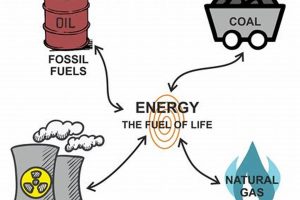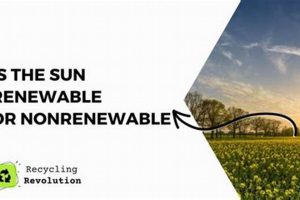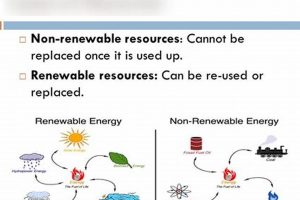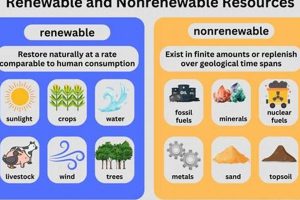
Finite resources, like fossil fuels (coal, oil, and natural gas) and nuclear fuels (uranium), are formed over geological timescales and are depleted faster than they can be replenished. For example, coal is... Read more »

Solar energy, derived from the sun’s radiation, is perpetually replenished. Unlike resources like fossil fuels, which are finite and depletable, the sun’s energy is effectively limitless on a human timescale. This continuous... Read more »

Energy resources are categorized based on their replenishment rates. Those derived from sources that naturally replenish over a human timescale are considered sustainable. Examples include solar, wind, hydro, geothermal, and biomass energy.... Read more »

Energy resources are categorized as either renewable or nonrenewable. Renewable resources, such as solar, wind, and hydroelectric power, are naturally replenished over relatively short periods. Nonrenewable resources, on the other hand, exist... Read more »

This article addresses whether atmospheric airflow represents an exhaustible resource. Its classification hinges on the source of its energy and its capacity for natural replenishment. Examination of the underlying processes reveals key... Read more »

Examining the distinctions between energy derived from replenishable resources and that from finite reserves reveals key differences in availability, environmental impact, and long-term sustainability. For instance, solar power, a replenishable resource, harnesses... Read more »

The atmosphere’s gaseous composition, crucial for life on Earth, is maintained through a complex interplay of natural processes. Oxygen, vital for respiration, is continuously replenished through photosynthesis by plants and algae. Other... Read more »

The nature of electrical power generation hinges on its source. Some sources are naturally replenished over a relatively short period, while others are finite and depletable. For example, solar power harnesses sunlight,... Read more »

Crude oil, formed from the remains of ancient organisms over millions of years, is classified as a non-renewable resource. This means its rate of formation is significantly slower than its rate of... Read more »



